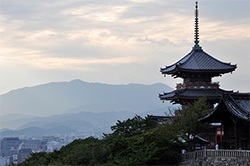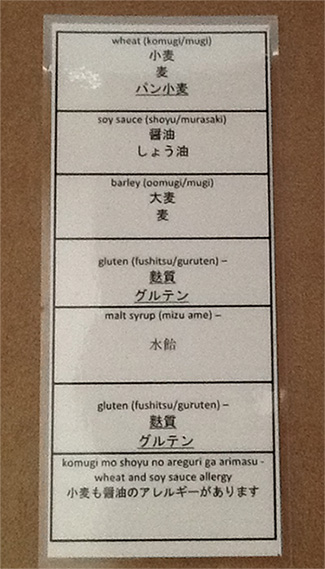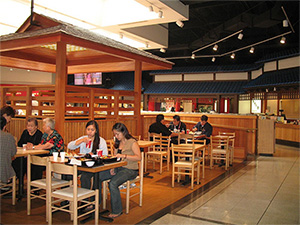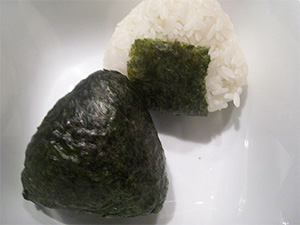Home > Gluten Free Travel Stories > Getting Gluten Free Food in Japan
Getting Gluten Free Food in Japan
Tweet
Japan. Courtesy of Doug
by Clare B, Vancouver, Canada
I just got back from Japan and I have a couple of thoughts that will hopefully be helpful to other people with Celiac disease looking to travel to Japan.
To start I would say that I absolutely loved Japan despite how frustrating it was find things that I could eat. Before I left for the trip I did quite a bit of research to get an idea of what food I would almost always be able to eat. There were a number of blogs that also helped me put together my own "translation card" with key phrases in Japanese and the characters for wheat, soy sauce, barley, malt syrup and gluten.Â
I have attached a picture of the card I ended up using the most. I found this card quite helpful because it allowed me to have a bit more of a dialogue with the Japanese speaker who was helping me at the restaurant/store/food counter.

Japanese Gluten Free Card (you can get our one here)
I would just point to the box that says "wheat and soy sauce allergy" and then the Japanese speaker could point to whatever ingredient on the list is problematic. Although obviously this card doesn't explain Celiac disease, from the research I had done food allergies are taken quite seriously in Japan (even though they are not very prevalent among Japanese people) so to simplify things and emphasize the seriousness of the situation I just used "wheat and soy sauce allergy" to address to main problem ingredients.
Barley is also quite common in Japan, barley tea is even quite prevalent, as it malt syrup but I just avoided anything that might have those ingredients in it so it wasn't really an issue. This card also made it quite helpful to look at the ingredients in pre-packaged foods to figure out of there was wheat in the item (which there almost always was).
Gluten Free Sushi and Yakitori
I managed to get by quite well eating primarily sushi and yakitori seasoned with salt and without any sauce (grilled chicken skewers). While it was relatively easy to find yakitori seasoned with salt, but sushi was a bit more difficult because for some strange reason quite a few sushi restaurants or counters in Japan put wheat in their sushi rice.
I would use my card (and sometimes also my phrasebook) to ask the restaurant or food counter whether there wheat in the sushi/sushi rice. I would also use my food card when going out for yakitori just to be extra careful. Everyone in Japan is so wonderful and helpful once I showed them my food card whomever I was dealing would always make sure to check with the chef to make sure everything was okay.
Often they would even take my card and give it to the chef so he could look at it. Once or twice I think the restaurant/food counter was being overly cautious in telling me that everything on their menu had wheat in it which I think was really them trying to warn me about cross-contamination. I even had one chef go so far as to ask about anaphylaxis which was about the only word he knew in English which really proved to me how seriously my "allergy" was being taken.
I would say the sushi I encountered was gluten-free about 70% of the time (obviously avoiding anything with tempura or fake crab) and every time there was wheat in the sushi rice it was at a restaurant rather than a good counter.
Grocery Stores and Food Halls in Department Stores - Good for Gluten Free

Japanese Food Hall. Courtesy of AlBakker
One thing that I found really helpful about Japan was that almost every major train/subway station seems to have a department store attached to it and in the basement level of the department store there is always a "food hall" and possibly also a grocery store. The food halls are filled with counters selling pre-made food to go such as tempura, gyoza, assorted desserts and of course sushi rolls and yakitori.
Depending on the food hall you are in they can be quite fancy. This made life a lot easier especially for lunches on the go and train rides. Plus they were just fun to walk around and look at everything.
Grocery stores also always had sushi and yakitori to go as well as other standard grocery store foods. I got quite familiar with the Japanese pictogram for wheat so that we could look out for it on Japanese processes foods and there was almost always wheat in items that really shouldn't have wheat in them (pretty much every brand of potato chips for example, even ones that don't have wheat in them in Canada).
Japanese Rice Ball Snacks

Japanese Rice Ball. Courtesy of Tare Panda
An on the road snack that I found quite handy are the Japanese rice ball snacks (they are actually generally triangle shaped) that are sold at every convenience store. These are generally sticky rice wrapped in seaweed and contain some sort of filling (could be tuna or pickled plum, but not knowing Japanese it is impossible to tell).
These snacks are a bit tricky and it was very difficult to know which of these snacks had wheat in them and which did not without really scouring the ingredient list for the wheat pictogram because they all look the same and some of them contain wheat and some don't.
Take Gluten Free Soy Sauce (Tamari) With You
Something else that really helped me not feel too limited by just sushi and yakitori is that I brought my own travel sized packages of gluten free soy sauce so that I could at least have soy sauce with everything. San-J makes gluten free Tamari travel packs which you can buy online and in stores. I looked everywhere for them and was finally able to find the travel packs at Whole Foods in Canada.
Despite how delicious the sushi and yakitori was in Japan, it did get a bit old and constantly using my gluten free card got a bit annoying so for a longer trip to Japan (I was there for 10 days) I would recommend staying somewhere with kitchen facilities for at least part of the trip.
We stayed at a wonderful place in Kyoto with a full kitchen (pots, dishes, stove etc) and a very gracious host called Oil Street Guest House which I would definitely recommend. I also brought a bottle of gluten free soy sauce with me for cooking and we were able to make some delicious stir frys at the guest house which was a nice break from sushi and yakitori.
We also went out for Indian a couple of times in Kyoto (and could have done so in Tokyo as well) which was a great option. Other traditionally gluten free options such as Indian and Thai restaurants are available in Tokyo and Kyoto but I read that (not too surprisingly) the smaller the city you go to the more difficult it is to find anything but traditional Japanese food.
This ended up being much longer than I anticipated, but I hope it is helpful when you get questions about travelling in Japan. If you have any questions or there is any other information you think might be helpful please do not hesitate to ask!
Thanks to these blogs that really helped me in my research:
Japan is not the Gluten-free Mecca You Think It is
Gluten Free in Japan
Your Guide to Gluten Free Adventuring in Japan
---------------------
Wherever you're going, remember to take a free gluten free restaurant card with you.
I hope that this celiac travel story has helped you. You can help other celiacs travel more safely by telling me about getting gluten free food in your area - remember where you live is a destination too! Send me a report and I'll let thousands of celiacs know.
Go back to Celiac Travel Stories



